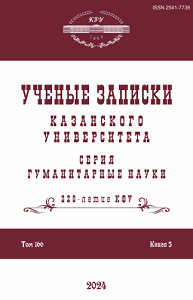История слова ценинный в русском языке (семантические модификации)
The History of the Word tseninnyi in the Russian Language (Semantic Modifications)
Author(s): G. Kh. Gilazrtdinova, Lilija Renadovna AkhmerovaSubject(s): Theoretical Linguistics, Lexis, Semantics, Historical Linguistics, Eastern Slavic Languages
Published by: Казанский (Приволжский) федеральный университет
Keywords: Russian language; written records; etymology; semantics; adjective tseninnyi;
Summary/Abstract: This article explores the origins and functioning of the lexeme tseninnyi throughout the history of the Russian language, focusing on its role as a color term with Oriental roots. Its semantic evolution was traced using a variety of sources, including historical, etymological, and dialect dictionaries, as well as Old Russian texts. The analysis is based on 1) systemic-linguistic, or paradigmatic, and 2) etymological aspects. In Old Russian texts, this term refers to a shade of blue (tseninnyi1 ) and glazed ceramics with blue enamel (tseninnyj2 ). Both of these meanings emerged almost simultaneously in the second half of the 16th century. As a color name, tseninnyi fell out of use before the end of the 17th century, largely due to changing fashion trends as the expensive textiles in this color gradually became unpopular. At the same time, tseninnyi, when used in architectural language to denote glazed ceramics and tiles with a monochrome pattern, has proved to be more enduring and survived up to the present day.
Journal: Ученые записки Казанского университета. Серия Гуманитарные науки
- Issue Year: 166/2024
- Issue No: 5
- Page Range: 129-140
- Page Count: 12
- Language: Russian

